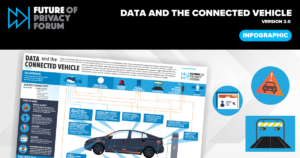Updated FPF Infographic Explores Data in Connected Vehicles
Today, The Future of Privacy Forum is launching the Data and the Connected Vehicle Infographic 2.0, including new updates to account for the types of data associated with connected vehicles, features in and outside of the vehicle, and data handlers who receive and process data. Lawmakers, manufacturers, privacy professionals, and consumers are actively engaged in work to examine and respond to privacy and transparency practices related to personal data collected in and around vehicles. The updated infographic provides a visual representation of where the data flows within the connected vehicle ecosystem.
In 2017, FPF launched the first vehicle infographic, “Data and the Connected Car.” FPF’s continued work on connected vehicles has built upon this initial product, providing additional resources, up to and including the Vehicle Safety Systems Privacy Risks and Recommendations report from March 2024. The report specifically highlights the potential for privacy risks to exist when new technology is incorporated, through requirement or choice, In addition to comments to the Department of Transportation regarding privacy implications for future technology and privacy implications for the future use of AI in transportation.
Click here to view the updated infographic.
The updated infographic highlights three specific areas within the connected vehicle ecosystem:
- 1. Types of Data in the Vehicle include vehicle and safety data, occupant data, location data, account data, and biometric and body-related data. Artificial intelligence is likely to be present in various features and functions throughout the vehicle. Understanding the types and categories of data associated with connected vehicles is essential for regulating data and increasing privacy literacy among individual drivers and passengers. Some data, like operational information or data on engine health, is integral to the vehicle functions, while other types of data can be user-generated and intended for personalization or driver assistance, including GPS navigation and usage of smartphone integration.
- 2. Features Inside and Outside the Vehicle include technologies such as infotainment systems, event data recorders, and tire sensors. Additional novel technologies may be more commonly incorporated into vehicles in the future. Some of the vehicle technologies may be added after-market by individuals or are specific to a certain vehicle make and model, such as keyless entry, augmented reality displays, or external charging. Certain vehicle features may be governed by specific requirements and rules according to state and federal regulations. In addition, manufacturers are increasingly incorporating certain technologies specifically in response to emerging regulatory requirements. An increase in technology and data collection can increase the privacy risk associated with the vehicle.
- 3. Data Receivers or Data Handlers are entities who collect and control the flow of data from inside and outside the vehicle for various purposes, including performance and safety. Once the data is collected, its transfer and use can depend on a number of factors, including agreements with the manufacturer, third parties and service providers, emergency services, and external infrastructure such as traffic lights and automatic license plate readers. Manufacturers may receive vehicle and safety data, location data, account data, occupant data, and biometric or body-related data (depending on the technology incorporated into the vehicle). Third parties and service providers may also receive information about the vehicle and potentially about the user. Some third parties in the connected vehicle ecosystem include insurance companies, dealerships and service centers, and entities that provide in-vehicle services through the infotainment system. Notice to individuals should provide information about when data is required for the vehicle to function or for important safety or regulatory requirements.
Individuals should feel physically and digitally safe in their vehicles. In 2023, FPF conducted a survey wherein consumers indicated that transparency is important to trust and adoption of in-vehicle technologies intended to increase safety. This updated infographic can help provide people with transparency by providing a visual demonstration to foster an understanding of how technology is utilized in a vehicle and where personal data may be implicated. Additionally, this infographic can serve as a resource for policymakers who need to understand the ecosystem in order to regulate effectively. As vehicle privacy continues to be top of mind for all individuals, the updated FPF infographic serves to help improve understanding and provide the transparency that is needed for a trusted mobility ecosystem.



